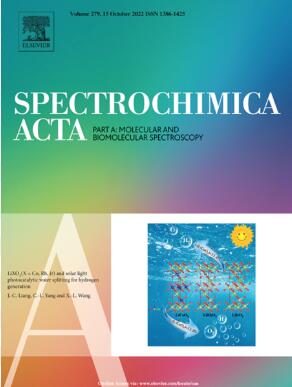通过氧化和n-π*跃迁调制激子转移途径,实现高效的室温磷光
IF 4.6
2区 化学
Q1 SPECTROSCOPY
Spectrochimica Acta Part A: Molecular and Biomolecular Spectroscopy
Pub Date : 2025-06-30
DOI:10.1016/j.saa.2025.126625
引用次数: 0
摘要
有机室温磷光(RTP)材料在显示技术和信息加密领域具有广阔的应用前景。实现高效的RTP发射依赖于精确调节激发态特性和发光途径。在本研究中,选择了三个实验报道的供体-受体分子,并通过第一性原理计算系统地研究了氧化对其光物理性质的影响。结果表明,供体单元的氧化有效地调节了分子内电荷转移特性和激发态能级,从而影响了反向系统间交叉(RISC)和激子转移过程,揭示了相关的热激活延迟荧光(TADF)和RTP发射机制。在所研究的分子中,完全氧化的DOPTZ-CO分子表现出最有利的RTP性能。以DOPTZ为氧化给体,进一步设计了三个具有明显n-π*跃迁特征的分子,并提出了一种通过加入非键(n)轨道来调节发射途径的新策略。n-π*跃迁的引入起到了双重作用:增强了自旋轨道耦合(SOC)效应,促进了辐射T1-S0跃迁,增加了S1-T1的能隙(ΔEST),从而抑制了RISC过程,有利于rtp主导的发射。因此,具有中等ΔEST值(约0.4 eV)和强n-π*特征的分子表现出有效和可控的RTP行为。总之,本研究强调了激发态调制和轨道工程在调谐发射路径中的重要作用,为高性能有机RTP材料的合理设计提供了理论基础。本文章由计算机程序翻译,如有差异,请以英文原文为准。

Modulating exciton transfer pathways via oxidation and n-π* transitions for efficient room-temperature phosphorescence
Organic room-temperature phosphorescence (RTP) materials hold promising applications in the field of display technologies and information encryption. Achieving efficient RTP emission relies on precisely regulating excited-state properties and luminescence pathways. In this study, three experimentally reported donor-acceptor molecules are selected, and the effects of oxidation on their photophysical properties are systematically investigated by first-principles calculations. The results show that oxidation of the donor units effectively modulates intramolecular charge transfer characteristics and the excited state energy levels, thereby influencing the reverse intersystem crossing (RISC) and exciton transfer processes, related thermally activated delayed fluorescence (TADF) and RTP emission mechanisms are revealed. Among the studied molecules, the fully oxidized molecule DOPTZ-CO exhibits the most favorable RTP performance. Using DOPTZ as the oxidized donor, three molecules featuring pronounced n-π* transition characteristics are further designed, and a novel strategy is proposed to regulate emission pathways by incorporating non-bonding (n) orbitals. The introduction of n-π* transition is found to play a dual role: it enhances spin-orbit coupling (SOC) effect, facilitating radiative T1-S0 transitions and it also increases the S1-T1 energy gap (ΔEST), thereby suppressing RISC process and favoring RTP-dominated emission. Thus, molecules with moderate ΔEST values (approximately 0.4 eV) and strong n-π* character demonstrate efficient and controllable RTP behavior. Overall, this study underscores the critical role of excited-state modulation and orbital engineering in tuning emission pathways and provides a theoretical foundation for the rational design of high-performance organic RTP materials.
求助全文
通过发布文献求助,成功后即可免费获取论文全文。
去求助
来源期刊
CiteScore
8.40
自引率
11.40%
发文量
1364
审稿时长
40 days
期刊介绍:
Spectrochimica Acta, Part A: Molecular and Biomolecular Spectroscopy (SAA) is an interdisciplinary journal which spans from basic to applied aspects of optical spectroscopy in chemistry, medicine, biology, and materials science.
The journal publishes original scientific papers that feature high-quality spectroscopic data and analysis. From the broad range of optical spectroscopies, the emphasis is on electronic, vibrational or rotational spectra of molecules, rather than on spectroscopy based on magnetic moments.
Criteria for publication in SAA are novelty, uniqueness, and outstanding quality. Routine applications of spectroscopic techniques and computational methods are not appropriate.
Topics of particular interest of Spectrochimica Acta Part A include, but are not limited to:
Spectroscopy and dynamics of bioanalytical, biomedical, environmental, and atmospheric sciences,
Novel experimental techniques or instrumentation for molecular spectroscopy,
Novel theoretical and computational methods,
Novel applications in photochemistry and photobiology,
Novel interpretational approaches as well as advances in data analysis based on electronic or vibrational spectroscopy.

 求助内容:
求助内容: 应助结果提醒方式:
应助结果提醒方式:


